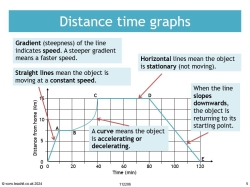Distance time graphs

Introduce or revise distance time graphs with this comprehensive resource pack which includes a printable A3 review sheet and PowerPoint presentation to guide students through step by step with summary notes, examples and practice questions.
What’s included?
This resource pack has everything you need to introduce or revise distance time graphs in maths. Download the free printable A3 review sheet for detailed notes and practice questions (with answers included).
Subscribe to access an editable version plus a step-by-step PowerPoint which walks students through:
- An introduction to distance time graphs
- How to read distance time graphs — steps, examples and practice questions
- How to draw distance time graphs — steps, examples and practice questions
- Common misconceptions
How to use these distance time graph resources
These resources are ideal for introducing or revising distance time graphs with your students.
- The PowerPoint presentation provides a guide through the topic, beginning with an introduction to distance time graphs, followed by detailed instructions on how to read and draw these graphs, supplemented with examples and practice questions.
- The printable A3 review sheet serves as a comprehensive reference, complete with notes, practice questions and answers. It can be used in class for group activities or as a revision tool for students to take home.
Looking for more like this?
For more resources that help students learn about speed, distance and time graphs, you might like to try:
An extract from 'How to read distance time graphs':
1. Look at the x-axis to understand the time scale that is being used. This could be seconds, minutes, hours, or even days.
2. Look at the y-axis to understand the distance scale that is being used. This could be in metres, kilometres, miles, etc.
3. Examine the line on the graph.
The gradient (steepness) of the line indicates speed. A steeper gradient means a faster speed.
Straight lines mean the object is moving at a constant speed.
Horizontal lines mean the object is stationary (not moving).
When the line slopes downwards, the object is returning to its starting point.
A curve means the object is accelerating or decelerating.
